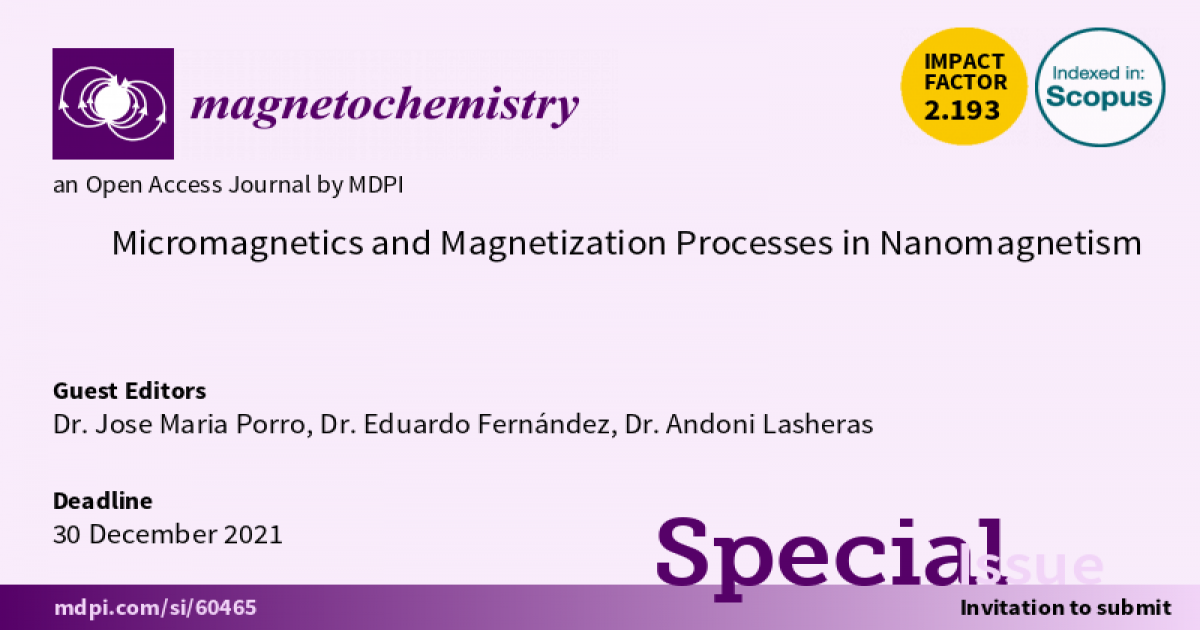Micromagnetics and Magnetization Processes in Nanomagnetism
A special issue of Magnetochemistry (ISSN 2312-7481). This special issue belongs to the section "Magnetic Nanospecies".
Deadline for manuscript submissions: closed (30 December 2021) | Viewed by 7603

Special Issue Editors
2. IKERBASQUE, Basque Foundation for Science, Plaza Euskadi 5, 48009 Bilbao, Spain
Interests: nanomagnetism; advanced nanofabrication; micromagnetics; magnetization dynamics; neutron scattering techniques; synchrotron techniques
Interests: micro- and nanolithography; magnetic characterization; high-frequency measurements; magnetic sensors; finite elements magnetic simulations
Interests: ferromagnetic materials fabrication; ferromagnetic materials characterization; magnetostrictive and magnetoelastic materials; magnetoelectric sensors
Special Issues, Collections and Topics in MDPI journals
Special Issue Information
Dear Colleagues,
It is with great pleasure that we present this Special Issue “Micromagnetics and Magnetization Processes in Nanomagnetism”, allowing the nanomagnetism community the opportunity to contribute with the submission of review papers, full articles, and short communications.
Nanomagnetism comprises the study of the novel physical phenomena that appear when magnetic systems are reduced to the nanoscale. Current thin film growth technology allows fabricating thin films and multilayers at sub-nanoscale and all the way down to angstrom precision. In addition, the precise control in nanoscale fabrication offered by modern lithography now makes it possible to produce samples composed of high-quality nanostructures in magnetic films. This new control over the sizes, periods, and symmetry of nanostructures enables not only the fabrication of new systems of potential technological interest but also systems in which fundamental properties of mesoscopic matter can be investigated in depth.
This Special Issue focuses on different areas of nanomagnetism. Contributions to the collection may cover topics including but not limited to magnetization processes in magnetic nanostructures, magnetic thin films and multilayers, micromagnetic simulations, magnetization dynamics, and magnetization reversal processes, among others.
Dr. Jose Maria Porro
Dr. Eduardo Fernández
Dr. Andoni Lasheras
Guest Editors
Manuscript Submission Information
Manuscripts should be submitted online at www.mdpi.com by registering and logging in to this website. Once you are registered, click here to go to the submission form. Manuscripts can be submitted until the deadline. All submissions that pass pre-check are peer-reviewed. Accepted papers will be published continuously in the journal (as soon as accepted) and will be listed together on the special issue website. Research articles, review articles as well as short communications are invited. For planned papers, a title and short abstract (about 250 words) can be sent to the Editorial Office for assessment.
Submitted manuscripts should not have been published previously, nor be under consideration for publication elsewhere (except conference proceedings papers). All manuscripts are thoroughly refereed through a single-blind peer-review process. A guide for authors and other relevant information for submission of manuscripts is available on the Instructions for Authors page. Magnetochemistry is an international peer-reviewed open access monthly journal published by MDPI.
Please visit the Instructions for Authors page before submitting a manuscript. The Article Processing Charge (APC) for publication in this open access journal is 2200 CHF (Swiss Francs). Submitted papers should be well formatted and use good English. Authors may use MDPI's English editing service prior to publication or during author revisions.
Keywords
- magnetic nanostructures
- magnetic thin films and multilayers
- micromagnetic simulations
- magnetization dynamics
- patterned magnetic thin films
- magnetization reversal
Benefits of Publishing in a Special Issue
- Ease of navigation: Grouping papers by topic helps scholars navigate broad scope journals more efficiently.
- Greater discoverability: Special Issues support the reach and impact of scientific research. Articles in Special Issues are more discoverable and cited more frequently.
- Expansion of research network: Special Issues facilitate connections among authors, fostering scientific collaborations.
- External promotion: Articles in Special Issues are often promoted through the journal's social media, increasing their visibility.
- Reprint: MDPI Books provides the opportunity to republish successful Special Issues in book format, both online and in print.
Further information on MDPI's Special Issue policies can be found here.







